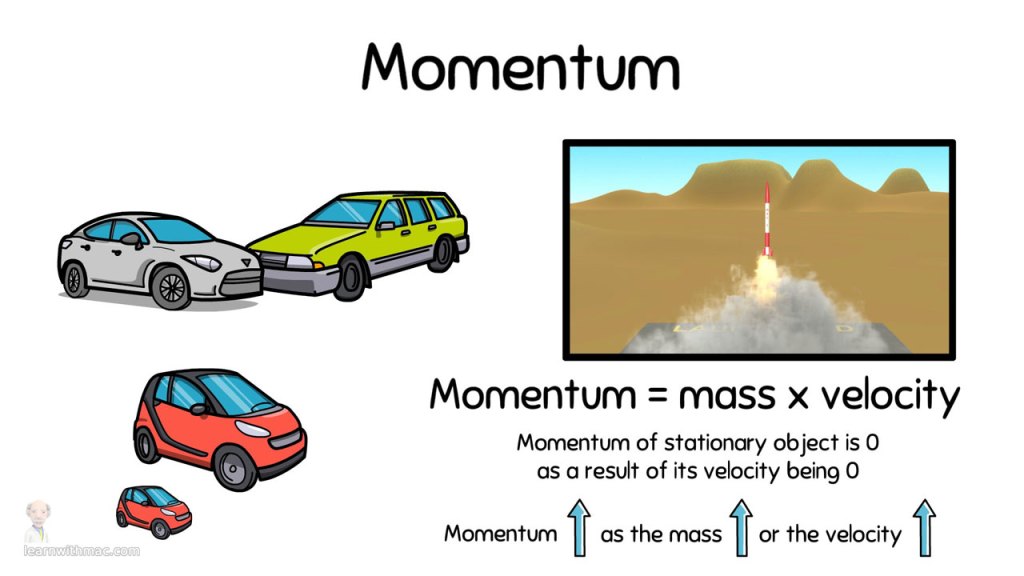- Books Name
- Science Made Easy Science Book
- Publication
- Science Made Easy
- Course
- CBSE Class 9
- Subject
- Science
Momentum
→ Momentum is the power of motion of an object.
→ The product of velocity and mass is called the momentum. Momentum is denoted by ‘p’.
→ Therefore, Momentum of the object = Mass × Velocity (p = m × v)
where, p = momentum, m = mass of the object and v = velocity of the object.

• Some explanations to understand the momentum:
→ A person get injured in the case of hitting by a moving object, such as stone, pebbles or anything because of momentum of the object.
→ Even a small bullet is able to kill a person when it is fired from a gun because of its momentum due to great velocity.
→ A person get injured severely when hit by a moving vehicle because of momentum of vehicle due to mass and velocity.
Momentum and Mass
→ Since momentum is the product of mass and velocity (p = m × v) of an object. This means momentum is directly proportional to mass and velocity. Momentum increases with increase of either mass or velocity of an object.
→ This means if a lighter and a heavier object is moving with same velocity, then heavier object will have more momentum than the lighter one.
→ If a small object is moving with great velocity, it has tremendous momentum. And because of momentum, it can harm an object more severely.
Example: a small bullet having a little mass even kills a person when it is fired from a gun.
→ Usually, road accidents prove more fatal because of high speed than in slower speed. This happens because vehicles running with high speed have greater momentum compared to a vehicle running with slower speed.
Momentum of an object which is in the state of rest
Let an object with mass ‘m’ is in the rest.
Since, object is in rest, therefore, its velocity, v = 0
Now we know that,
Momentum = mass × velocity
⇒ p = m × 0 = 0
Thus, the momentum of an object in the rest i.e. non-moving, is equal to zero.
Unit of momentum
→ SI unit of mass = kg
→ SI unit of velocity = m/s
We know that,
Momentum (p) = m × v
∴ p = kg × m/s ⇒ p = kg m/s
Numerical Problems Based on Momentum
Type I: Calculation of Momentum
Example 1: What will be the momentum of a stone having mass of 10 kg when it is thrown with a velocity of 2 m/s?
Solution
Mass (m) = 10 kg
Velocity (v) = 2 m/s
We know that,
Momentum (p) = Mass (m) × Velocity (v)
∴ p = 10 kg × 2 m/s = 20 kg m/s
Thus, the momentum of the stone = 20 kg m/s.
Example 2: Calculate the momentum of a bullet of 25 g when it is fired from a gun with a velocity of 100 m/s.
Solution
Given, Velocity of the bullet (v) = 100 m/s
Mass of the bullet (m) = 25 g = 25/1000 kg = 0.025 kg
Since, p = m × v
∴ p = 0.025 × 100 = 2.5 kg m/s
Momentum of the bullet = 2.5 kg m/s.
Example 3: Calculate the momentum of a bullet having mass of 25 g is thrown using hand with a velocity of 0.1 m/s.
Solution
Given, Velocity of the bullet (v) = 0.1 m/s
Mass of the bullet (m) = 25 g = 25/1000 kg = 0.025 kg
Momentum (p) = Mass (m) × Velocity (v)
∴ p = 0.025 kg × 0.1 m/s
⇒ p = 0.0025 kg m/s
Momentum of the bullet = 0.0025 kg m/s.
Example 4: The mass of a goods lorry is 4000 kg and the mass of goods loaded on it is 20000 kg. If the lorry is moving with a velocity of 2 m/s, what will be its momentum?
Solution
Given, Velocity (v) = 2 m/s
Mass of lorry = 4000 kg
Mass of goods on the lorry = 20000 kg
∴ Total mass (m) on the lorry = 4000 kg + 20000 kg = 24000 kg
Momentum (p) = Mass (m) × Velocity (v)
∴ p = 24000 kg × 2 m/s
⇒ p = 48000 kg m/s
Momentum of the lorry = 48000 kg m/s.
Example 5: A car having mass of 1000 kg is moving with a velocity of 0.5 m/s. What will be its momentum?
Solution
Given, Velocity of the car (v) = 0.5 m/s
Mass of the car (m) = 1000 kg
Momentum (p) = Mass (m) × Velocity (v)
∴ p = 1000 kg × 0.5 m/s = 500 kg m/s
Momentum of the car = 500 kg m/s.

 Science Made Easy
Science Made Easy
